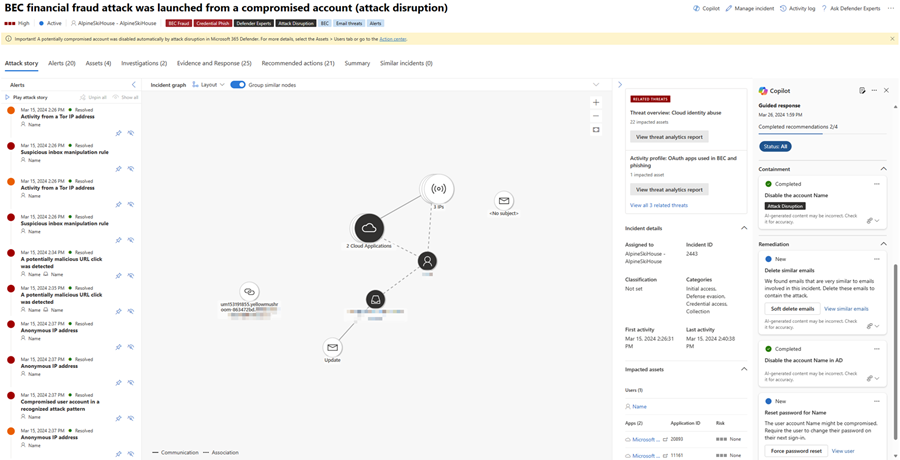Triage and investigate incidents with guided responses from Microsoft Copilot in Microsoft Defender
Applies to:
- Microsoft Defender XDR
- Microsoft Defender unified security operations center (SOC) platform
Microsoft Copilot for Security in the Microsoft Defender portal supports incident response teams in immediately resolving incidents with guided responses. Copilot in Defender uses AI and machine learning capabilities to contextualize an incident and learn from previous investigations to generate appropriate response actions.
Responding to incidents in the Microsoft Defender portal often requires familiarity with the portal's available actions to stop attacks. In addition, new incident responders might have different ideas of where and how to start responding to incidents. The guided response capability of Copilot in Defender allows incident response teams at all levels to confidently and quickly apply response actions to resolve incidents with ease.
Guided responses are available in the Microsoft Defender portal through the Copilot for Security license. Guided responses are also available in the Copilot for Security standalone experience through the Defender XDR plugin.
This guide outlines how to access the guided response capability, including information on providing feedback about the responses.
Apply guided responses to resolve incidents
Guided responses recommend actions in the following categories:
- Triage - includes a recommendation to classify incidents as informational, true positive, or false positive
- Containment - includes recommended actions to contain an incident
- Investigation - includes recommended actions for further investigation
- Remediation - includes recommended response actions to apply to specific entities involved in an incident
Each card contains information about the recommended action, including the entity where the action needs to be applied and why the action is recommended. The cards also emphasize when a recommended action was done by automated investigation like attack disruption or automated investigation response.
The guided response cards can be sorted based on the available status for each card. You can select a specific status when viewing the guided responses by clicking on Status and selecting the appropriate status you want to view. All guided response cards regardless of status are shown by default.
To use guided responses, perform the following steps:
Open an incident page. Copilot automatically generates guided responses upon opening an incident page. The Copilot pane appears on the right side of the incident page, showing the guided response cards.
Review each card before applying the recommendations. Select the More actions ellipsis (...) on top of a response card to view the options available for each recommendation. Here are some examples.


To apply an action, select the desired action found on each card. The guided response action on each card is tailored to the type of incident and the specific entity involved.
You can provide feedback to each response card to continuously enhance future responses from Copilot. To provide feedback, select the feedback icon
 found on the bottom right of each card.
found on the bottom right of each card.
Note
Grayed out action buttons mean these actions are limited by your permission. Refer to the unified role-based access (RBAC) permissions page for more information.
Copilot in Defender supports incident response teams by enabling analysts to gain more context about response actions with additional insights. For remediation responses, incident response teams can view additional information with options like View similar incidents or View similar emails.
The View similar incidents action becomes available when there are other incidents within the organization that are similar to the current incident. The Similar incidents tab lists similar incidents that you can review. Microsoft Defender automatically identifies similar incidents within the organization through machine learning. Incident response teams can use the information from these similar incidents to classify incidents and further review the actions done in those similar incidents.
The View similar emails action, which is specific to phishing incidents, takes you to the advanced hunting page, where a KQL query to list similar emails within the organization is automatically generated. This automatic query generation related to an incident helps incident response teams further investigate other emails that might be related to the incident. You can review the query and modify it as needed.
See also
- Summarize an incident
- Analyze files
- Run script analysis
- Create an incident report
- Generate KQL queries
- Get started with Microsoft Copilot for Security
- Learn about other Copilot for Security embedded experiences
- Know more about preinstalled plugins in Copilot for Security
Tip
Do you want to learn more? Engage with the Microsoft Security community in our Tech Community: Microsoft Defender XDR Tech Community.
Feedback
Coming soon: Throughout 2024 we will be phasing out GitHub Issues as the feedback mechanism for content and replacing it with a new feedback system. For more information see: https://aka.ms/ContentUserFeedback.
Submit and view feedback for


